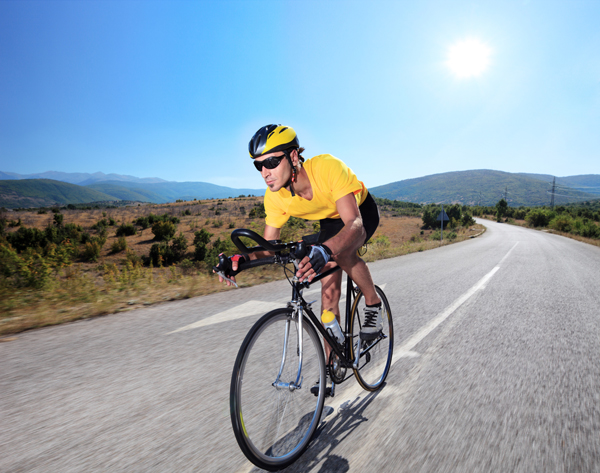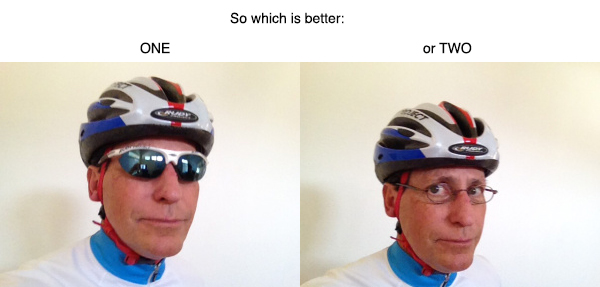
Because I love to ride, I encourage others to use bicycles to get around town or get a little exercise or just have fun. Many people hesitate to join me because of the stigma created by “avid” cyclists dressed in colorful, tight-fitting lycra, helmets, and the crazy shoes that make walking hilariously awkward. Others are simply uncomfortable on a bicycle saddle; others are concerned about being on the road and in the traffic. Some mistakenly believe you have to be in good shape to ride a bicycle. A common excuse for not riding is they need “the right bike “. One of the most common questions I’m asked is, “What kind of bike you have?“
I think this question is intended to find out how-how fancy and expensive my bike is. The high cost of a “toy” like a bicycle (or a fishing boat or a motorcycle) may indicate the passion of the owner (or their lack of good sense). The fact is, I ride a medium priced bike (less than $2,000 ten years ago), and I ride the heck out of it. But that’s not to say a newer, lighter bicycle wouldn’t make a difference. The price tag on the bicycle is only a portion of the cost of entry into the sport; when a good salesperson adds up all the accessories, the phrase, “the right equipment” comes into play. You need pedals (really?), a water bottle, tire pump, a set of tools, a saddlebag, helmet, riding shorts, a jersey (with the right logos), shoes, gloves (look ma! no fingers!), nutritional supplements, and, oh yeah, maybe a pair of cycling glasses. Generally overlooked by cyclists and often not a part of the bicycle accessories conversation, eyeglasses are an extremely important piece of cycling equipment. How well do you want to see? Are your everyday glasses suitable for cycling? Do they provide protection from the elements including the sun, wind, airborne pollutants, and road debris?
I’ve worked in the eye care industry most of my life, and I’ve seen much of our grand country from the saddle of a bicycle. Although I have pretty fair distance vision, I know how important it is to have a proper set of cycling glasses. Seeing well provides the measure of protection that can save you when something pops up unexpectedly requiring quick reflexes. Seeing just okay or poorly is not an option in my book.
Here’s the issue: when you’re riding a bicycle you will encounter numerous items that can either be an annoyance or life threatening. You want to see problems before you hit them. Things like holes or cracks in the pavement, rocks, sand, gravel, broken glass, nails, garbage, dogs, road kill, branches, thorns, bicyclists riding on the wrong side of the road, pedestrians, cars, trucks…the list goes on and on. It’s pretty important to be able to see way down the road, but it’s equally important when riding on tires that are only one inch wide to be able to see and avoid the debris that litters the road and can cause a flat tire. Bummer. Bicycles are relegated to a very small portion of the road, and it is often not the smoothest or best-maintained piece of the pavement.

The point is we need to be able to see at all distances and be able to react quickly. So if your eye care exam indicates you could benefit from a distance correction, you will want to get the prescription filled properly in a pair of frames suited for cycling. If you already see better than 20/20 in the distance, there are non-prescription sunglasses made expressly for cycling. The frames are lightweight and durable and wrap around the eyes to provide optimum protection from the sun, dust, pollen, bugs, and other road debris. My favorites are from Rudy Project® and have interchangeable lenses for any type of light conditions.
But what about those of us who have reached that wonderful stage in life called presbyopia? Presbyopia is a fancy term for that point in our lives when we may be able to see well in the distance but can no longer focus up close. Our arms are too short, the light isn’t bright enough, the font on the map is too small. I’ve encountered many ingenious ways of dealing with presbyopia: a pair of readers around their neck or in a pocket or on the top of the head. Fascinating. There are non-prescription wrap around bifocal sunglasses to help with map reading. Quite frankly, this solution is a shortcut and old school thinking. I want to be able to see well at all distances, not just two. Bifocals only provide two focal lengths, near and far, leaving the mid-range up for creative interpretation if you are over fifty years old. Remember Mr. Magoo? A significant part of our world is slightly beyond arms length and less than twenty feet away. So I prefer progressive lenses that allow me to see at all distances. It’s not a new invention, and, yes, they are more expensive than bifocals. I can hear an argument brewing from those who say, “progressive lenses are too expensive!”
And I say, “Would you rather save money or see better?” These same folks will spend thousands of dollars on wheels or helmets or carbon frames or shoes and pedals or a jersey with “Arrogant Bastard” emblazoned on it. While I am an advocate of “GOOD, BETTER, BEST” merchandising, I believe nothing trumps vision regarding our safety on a bike. And if you’re planning a cycling trip to Italy, you want to be able to see EVERYTHING! So go to an eye doctor who embraces the most current technology and knows how to build an exceptional pair of wrap around glasses. If they are good at it and are active outdoors, they probably have a set themselves. But if they are clueless about which frames in their inventory are appropriate for bicycling or whether the frames can be mounted with prescription lenses or how to compensate the prescription for a highly curved lenses mounted in a wrapped sports frame or the particulars of spectral-specific lenses…well, many eye doctors and so-called opticians are not well versed in these areas. Find a doctor who really understands why you are willing to spend the money and get the right set of glasses. You may have to shop around to find a qualified practitioner. Ask your bike dealer, other cyclists, and do some shopping. If you have reached presbyopia and have any kind of distance prescription, do yourself a favor: don’t try to buy progressive wrap-around cycling glasses on the internet. You’ll probably just be disappointed and frustrated.
An eye examination should be the starting point and should be much deeper than, “Which is better: one or two? “ There are technologies that provide a more accurate prescription than the old Snellen chart and the patient’s subjective response. For example, I Scription® from Carl Zeiss Vision refines the prescription to 1/100th diopter by taking an objective refraction and accounting for the higher order of aberrations in the visual system. This fancy science identifies “optical noise” that is not diagnosed in a traditional exam. By applying this information to the spectacle lenses, the patient can experience up to 20% improvement in clarity, especially at night and in low light. This technology is not available at all I doctors, so ask your doctor if they utilize I Scription® from Zeiss before you make your appointment.
Earlier, I alluded to compensated prescriptions that improve lens performance based on the way the frame fits the patient’s face. Interestingly enough, the angle at which the lenses address the face will also affect the performance of the lenses and how well you see through them. There are several technologies that digitally and accurately measure the angle of the lenses in relation to the patient’s face. These measurements are unique to each individual and different for every frame. Accuracy is especially important when utilizing the highly curved lenses and wrapped frames we use for cycling. When properly executed, a pair of cycling glasses should not just look good and provide protection from the sun and airborne debris; the wearer should have spectacular vision at all distances under any light condition. I want you to be safe and enjoy the view.
The frame for my personal riding glasses is a Rudy Project® Rydon. The high wrap follows my face contour, protecting my eyes from the sun’s rays and road debris. This frame is durable and sturdy and especially cool because it is designed to accept interchangeable lenses. Since I grew up in the eye care business, I have interchangeable progressive lenses for every conceivable light condition: clear lenses for nighttime; yellow lenses for overcast or early mornings, lightly tinted lenses with a flash mirror coating for variable light conditions; mirrored polarized lenses for bright, sunny days. This variety provides comfortable, precise vision no matter what the lighting conditions. I can even reuse the same frame when my prescription changes, but I may want a change of style or color on my next set.
My cycling glasses with four sets of lenses cost around $1500. Sounds a little scary, doesn’t it? Most people only ride their bikes on clear sunny days, so they should invest in one set of lenses, probably sunglasses, in a suitable wrap frame. I suggest polarized lenses for the most comfort and the best vision. In single vision, a good pair could be purchased for about the same cost as a set of cycling shoes and pedals. Would anyone spend that much on a pair of glasses? Good vision will keep you from running over broken glass or nails and could save you the unpleasant chore of changing a flat tire on the roadside. No guarantees, but you can dodge road debris much easier if you can see it. Precision vision provides you with an extra margin of safety in traffic, too. And if you like to speed down mountainsides on narrow twisting roads on a dirt single track, you want to be seeing your best. Or maybe you’re a newcomer to cycling; make sure your eyes are protected and you can see what’s down the trail.
It’s pretty easy to spend $10,000 on a bicycle and all the accessories, what some call “the right equipment.” That kind of investment would require a lot of commitment. Certainly, you can purchase an entry-level bike for scooting around town for a lot less. But whether you bike once a month on the bikeway or challenge yourself in endurance cycling events over extreme terrain, make sure the glasses you see through provide the safety and security of the best vision possible. Being safe means, you’ll be more likely to go out riding again tomorrow. After all, “the right equipment” is really what’s in our hearts. It’s the spirit to go out and enjoy doing something rather than watching other people have the adventure.












